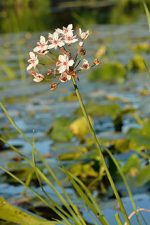 Also called grass rush, this aquatic perennial is native to in Eurasia and Africa where it grows in the margins of still and slowly moving water including lakes, riparian zones, wetlands, and marshes. It is a member of the Butomaceae, a small family of only one or two species, and is not a true rush. The plants were brought from Europe to the US as ornamentals in the early 1900s but have become invasive in the Great Lakes region and parts of the Pacific Northwest where it can displace native vegetation, alter water quality and supply, and impact recreational activities such as swimming and boating. Flowering rush likes full sun, wet soil and up to 9.8′ of water, but does not tolerate saline conditions. USDA Hardiness Zones 3-10 Photo Credit Wikipedia
Also called grass rush, this aquatic perennial is native to in Eurasia and Africa where it grows in the margins of still and slowly moving water including lakes, riparian zones, wetlands, and marshes. It is a member of the Butomaceae, a small family of only one or two species, and is not a true rush. The plants were brought from Europe to the US as ornamentals in the early 1900s but have become invasive in the Great Lakes region and parts of the Pacific Northwest where it can displace native vegetation, alter water quality and supply, and impact recreational activities such as swimming and boating. Flowering rush likes full sun, wet soil and up to 9.8′ of water, but does not tolerate saline conditions. USDA Hardiness Zones 3-10 Photo Credit Wikipedia
Description: The plants have a rhizomatous root system and grow to about 5′ tall. The linear leaves arise in two rows along the rhizome and are up to 3′ long and twisted. From mid to late summer terminal umbels of 20 to 50 light-pink to rose-colored scented flowers appear. Each flower is about 1″ across and has 3 petals and 3 petaloid, slightly smaller sepals. The fruit is a many-seeded capsule that ripens from late summer to early fall. Reproduction is by seed and rhizome fragmentation but some population are sterile and rely only on the latter.
Control: Control of flowering rush is very difficult and emphasis is placed on controlling spread and establishment of the plant by cleaning and drying all outdoor equipment and disposing of unwanted plants far away from bodies of water. In additions, gardeners should not plant flowering rush in their gardens.
Mechanical Control: Cutting the plants and digging up the rhizomes is possible but not very effective because the plants recover and can re-establish themselves very easily from remaining seeds or rhizomes.
Biological Control: There is currently no known biological control although in the native range of plant ducks they have been seen to vigorously feed on it and goats are known to feed on emergent vegetation.
Chemical Control: In severe infestations herbicides such as Roundup and mid-summer application of imazapyr may be effective but is difficult because the narrow twisted leaves of the plant tend to shed the chemicals. Extreme care must be used with either herbicide in order to avoid damage to other vegetation. There is no herbicide that targets flowering rush.